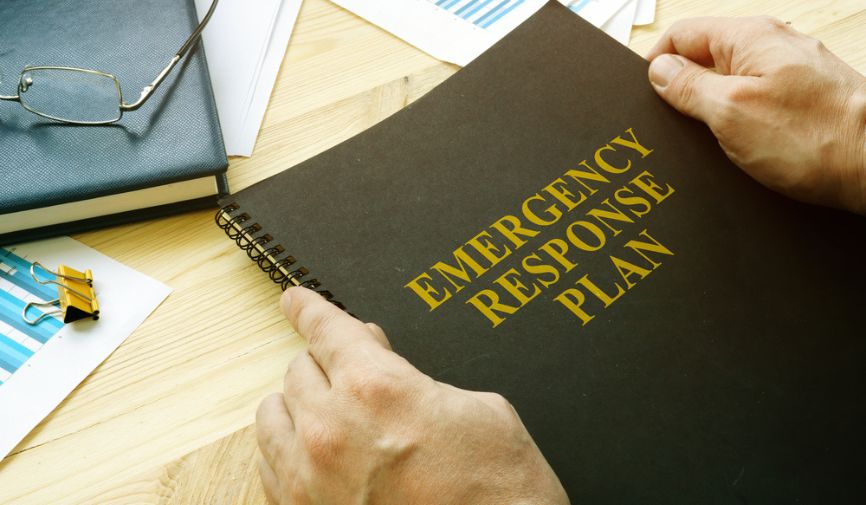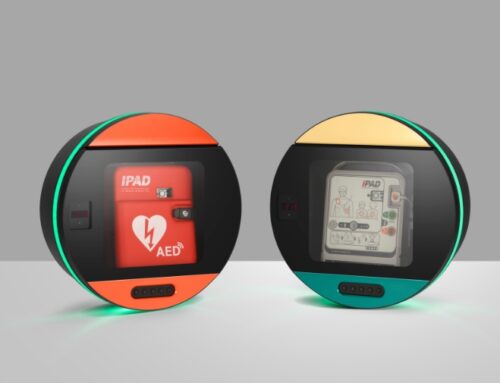[vc_row][vc_column][vc_column_text]There are over 30,000 out-of-hospital cardiac arrests each year in the UK, and around 25m people are admitted to A&E annually for concerns of all kinds, going by figures pre Covid-19.
Couple that with the fact that over three-quarters of the working-age population is in employment, and it’s wise for employers of all sizes to have an emergency response plan (ERP), keeping their people prepared should something unexpected occur.
In this post we’ll outline how to draw up an emergency preparedness plan for workplaces, including the risks to consider, the equipment you should source, and the steps your ERP should factor in.
What is emergency response planning?
An emergency response plan is a set of actions written formally into your company’s policies and procedures document, that’s designed to minimise the impact of an emergency and gives those experiencing it the best chance of survival and recovery.
Why is it important to have an emergency response plan?
There are many kinds of emergencies, from large-scale disasters like fires and terror attacks that can affect entire neighbourhoods, to cardiac events that affect one person directly, and impact those nearby emotionally. Whatever the situation, knowing the right course gives everyone involved a far greater chance of a positive outcome.
Out-of-hospital cardiac arrests, for instance, have a current survival rate of just one in ten; largely because people 1. aren’t trained with lifesaving knowledge and 2. don’t know where to find their nearest defibrillator. A well-circulated cardiac emergency response plan, along with training that supports it, can significantly increase those survival chances.
Creating your emergency response plan
Follow these steps to draw up a comprehensive emergency preparedness and response plan for your company.
Perform a risk assessment
[/vc_column_text][vc_empty_space][vc_single_image image=”2684″ img_size=”full”][vc_empty_space][/vc_column][/vc_row][vc_row][vc_column][vc_empty_space][vc_column_text]The first step in drawing up your emergency response plan is to take an overview of the key risks present in your business and understand the potential emergencies that could arise from them.
In the UK, a sensible list of emergencies to consider might include:
- Fire
- Flooding (particularly in areas near a large body of water)
- Terrorism of all kinds
- Environmental accidents (e.g. something heavy falling on someone, or a person being speared by a sharp object)
- Medical emergencies
Make sure your company has trained first aiders
Whatever the emergency, it’s a safe bet that people might need medical assistance – whether that be cleaning and bandaging open wounds or administering lifesaving CPR and defibrillation. So you should factor that in to your emergency preparedness plan for your workplace.
Smaller companies should make sure they have at least one first aid trained member of staff on their books. For larger companies, we’d suggest scaling the number of trained first aiders to cover your building’s population, while also allowing for their absence through holidays or flexible working patterns.
Source suitable lifesaving equipment
Even the most well-trained first aiders can only do so much without the right tools and equipment. That’s why the other part of your medical emergency response plan should be to source what they need, and make sure it’s placed somewhere sensible and accessible.
This equipment could include:
- First aid kits
- A defibrillator
- Fire extinguishers
- An alarm system (for instance, a fire alarm, or a silent alarm in businesses that handle large sums of cash).
Plan your emergency procedures
No emergency response plan would be complete without thoroughly detailing your emergency procedures. According to HSE, these include:
- Raising the alarm and informing members of the public
- On-site emergency response, for instance the use of fire extinguishers
- Calling emergency services and explaining to them what’s happening
- Managing crowds of people, including where necessary evacuating the building
- Helping people with disabilities to evacuate
- Managing traffic flow, including making a way for emergency vehicles
- Incident control
- Plus offering first aid and medical assistance – including the use of defibrillators if required.
Communicate and test your emergency procedures
[/vc_column_text][vc_empty_space height=”16px”][vc_single_image image=”2685″ img_size=”full”][vc_empty_space height=”16px”][vc_column_text]Finally, once you have an emergency preparedness plan for your workplace, you need to tell your people about it and make sure it works!
In some cases this could take the form of a table top exercise where your team can work through different scenarios. However, some procedures like fire evacuations should be tested several times a year by sounding the alarm and having your employees assemble in the designated areas.
A medical emergency response plan meanwhile may be slightly less easy to test, but that makes it all the more vital you have trained first aiders who will know what to do in case of an emergency. Those people should automatically know the location of your nearest defibrillator, and have your cardiac emergency response plan memorised in the event that the AED is needed.
Providing you with vital lifesaving equipment
So that’s our post on why you need an emergency response plan and how to go about creating one. For further details to help with drawing up your plan, see HSE’s guide to planning for incidents and emergencies.
Here at WEL Medical, we distribute what we believe is the most intuitive and accessible defib brand on the market, the iPAD range. We also stock our very own range of defibrillator cabinets, DefibSafe, and the most advanced range of CPR training manikins available anywhere, the Brayden line.
To learn how our products could help with your medical emergency response plan, see the blogs below or get in touch for an in-depth chat.[/vc_column_text][vc_empty_space][/vc_column][/vc_row][vc_row][vc_column][vc_column_text]
Related articles
- Choosing the Right Defibrillator
- What Happens When You Use A Defibrillator?
- Five Things You Should Do When You First Get Your Defibrillator
- World First Aid Day: CPR Guidance in a Covid-19 World
- Using CPR and Defibrillation on Children and Infants
[/vc_column_text][/vc_column][/vc_row]





